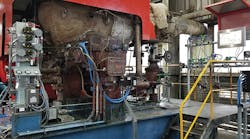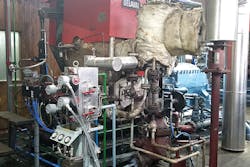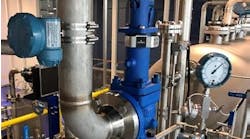Operators with the longtime competence and dedication necessary to manually manage complex industrial processes are priceless. But just because they've coped in the past doesn't mean they can't benefit from some assistance, automation and well-deserved peace of mind.
This was the case with the staff running the turbomachinery on the ethylene unit at Serbia-based HIP-PetroHemija. With an annual production capacity of more than 600,000 tonnes, the company is Serbia's largest producer of petrochemicals, polymers and synthetic rubber; has 40 years of production expertise; employs more than 1,400 staffers; and is one of its nation's largest exporters, contributing 1-3% of its total exports.
However, despite their historical achievements and ongoing successes, operators, engineers and managers running PetroHemija's ethylene unit dealt mainly with equipment that was installed in the 1970s and was manually controlled. Turbine speed was driven by mechanical governors; actuators were positioned by pressure-controlled pilots and worn linkages; and operators had to deal with obsolete, manual controllers, most of which had difficulty or no way to interface with the distributed control system (DCS). There was some limited vibration data, but it was on an isolated system, and not easy to access. These issues caused the ethylene unit to experience instability, high energy consumption, and high risk of unplanned trips or shutdowns.
"We started this project in 2019 with the main goals of improving stability of process control and enhancing surge protection, and all of this was achieved," says Aleksander Subotin, ethylene plant assistant director for production at PetroHemija. "Process parameters with upgrades from Schneider Electric were very stable, process disturbances are in the expected range, and there was no problem with operating our compressors at maximum capacity. It's working as it should work."
Greg Hanson, senior consultant with Schneider Electric’s Process Automation business, adds, "The amazing part is, even with all the production unit's former obstacles, the team at PetroHemija did an incredible job of keeping it operating day after day. We were excited to have the opportunity to upgrade this unit earlier this year, and give the extraordinary team at PetroHemija the peace of mind they needed and deserved."
Subotin, Hanson and PetroHemija's senior project manager, Bojan Janjic, presented "How have HIP-PetroHemija improved the performance of their critical assets?" at Innovation Talks: 2021 Foxboro and Triconex user groups in mid-September. [For articles on other event presentations, visit www.controlglobal.com/articles/2021/schneider-innovation-talks-2021]
Rundown on upgrades
Janjic reported that PetroHemija faced many challenges during its ethylene upgrade project, such as limited timeframes for installing equipment in its potentially explosive areas; achieving sufficient project team diversity; and performing remote factory acceptance test (FAT) to integrate its new systems with the plant's existing, old-fashioned hardware. "We had team members from countries on three continents, including Slovakia, Egypt, U.S., Czech Republic, Hungary, Poland, Croatia, Greece and Serbia," says Janjic. "Different business cultures, mindsets, social standards and time differences had to combine perfectly to guarantee successful project completion, and that's what we got."
The specific processes and equipment upgraded in PetroHemija's ethylene unit included:
- Crack gas compressor with four stages and two recycle valves driven by one extraction steam turbine;
- Propylene refrigeration compressor with two stages and two recycle valves also driven by one extraction steam turbine; and,
- Ethylene refrigeration compressor with three stages and two recycle valves driven by one steam valve turbine (Figure 1).
These processes and their devices gained new control cabinets housing Schneider Electric's Triconex triple-modular redundant (TMR) controllers, which feature decades of refined turbomachinery libraries. The unit's modernized controls were assigned to handle: standard turbine sequencing; speed controls; anti-surge detection and process surge decoupling for optimized surge prevention; extraction pressure and two-valve interactive control for the propylene refrigeration and crack gas processes; and various auxiliary controls for control oil, silicone oil and solenoid-operated check valves for all applicable machines. The unit also implemented Aveva's InTouch HMI software for its operator interfaces.
"These upgrades required a lot of patience and coordination from everyone, especially during relocation of the redundant, high-pressure (RHP) hydraulic unit, when we had to bridge a gap between design and reality," explains Janjic. "We also faced schedule slippage that threatened to jeopardize the project, so we all got together, and pooled our knowledge, experience and available resources to solve this issue. We improved the project's dynamics, picked the best execution strategy, and worked 24 hours onsite, so we could maximize our efficiency whenever possible."
Hanson adds the upgraded ethylene unit is fully integrated with its existing Bently Nevada vibration monitoring system and DCS. "New instrumentation was provided for the turbine controls, trip and throttles, valve actuators, and anti-surge valves," says Hanson.
For instance, each of the three turbines was also retrofitted with added speed probes, some dedicated to the control system and others for electronic over-speed protection. In addition, there are no more mechanical over-speed bolts to deal with, and each turbine now has a Schneider Electric Quadvoter trip block to facilitate API-compliant, electronic over-speed protection. Likewise, the unit's T&T valves were retrofitted with position feedback, servos for remote throttling, and solenoid-operated valves to enable remote, partial-stroke valve testing. Also, the former governor and extraction control actuators were replaced with modern, high-pressure actuators, including an integrated servo and redundant position feedback. All of these devices were powered by the new RHP unit that had to be installed at grade-level.
"Replacing the RHP unit was one of the biggest challenges," agrees Subotin. "It was originally planned to be in the elevated compressor hall. However, tests showed they had to be at ground level, and once we learned this, we were able to get it done fast."
Figure 2: To upgrade its ethylene unit, PetroHemija implemented Schneider Electric's Triconex triple-modular redundant (TMR) controllers with refined turbomachinery libraries and Aveva's InTouch HMI software, and integrated them with its existing Bently Nevada vibration monitoring system and DCS. Benefits gained include easier control with automated startups and shutdowns and user-friendly operator interfaces; enhanced control stability; increased plant production; optimized energy consumption; reduced chance of unplanned shutdowns; reduced operating and maintenance costs; and improved compliance with local environmental regulations. Source: HIP-PetroHemija and Schneider Electric
Benefits gained, results achieved
Following installation and startup, Janjic and Subotin report the upgrades to the ethylene unit's machines provided a host of advantages in its control room and in the field. These include:
- Easier control with automated startups and shutdowns and user-friendly operator interfaces;
- Enhanced control stability;
- Increased plant production;
- Optimized energy consumption;
- Reduced chance of unplanned shutdowns;
- Reduced operating and maintenance costs; and
- Improved compliance with local environmental regulations (Figure 2).
"In all, this project installed about 18 kilometers of different cables, so I just want to appreciate the patience of everyone involved that allowed us to complete this project successfully, and made us proud to watch the ethylene turbines and compressors come to life in a more efficient and effective way," concludes Janjic. "The business flexibility, transparency and mutual trust were just amazing, and represent the main pillars of this achievement. Having had this experience, I believe our teams could accomplish any project, especially those involving digital transformation. Lastly, we accomplished this project with no individual injury."







